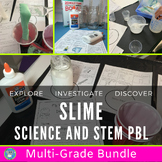Slime Science And STEM | Grade 4 5 | Properties Of Matter | Non Newtonian Fluids
- PDF
- Easel Assessment
Also included in
- Uncover the science of slime and save in this 3-grade level bundle. Perfect for the Science and STEM Teacher. Slime is a fantastic way to discover the properties of solids and liquids. Includes extensive background information to guide the teacher and students to success. Integrates well for HallowePrice $13.80Original Price $17.25Save $3.45
Description
Discover the science of slime and the properties of matter with 3 hands-on activities. Students will investigate the role of borax on viscosity. Explore further with other glues, and create your own slime in a STEM Challenge. Includes reading passages, teacher guide, Easel Assessment, and anchor charts. Perfect for Halloween. NGSS aligned for 5th Grade Structure and Properties of Matter.
Newly Added: We added a slime quiz in TpT Easel Assessments. It is 10 multiple-choice questions and is perfect as a pre or post-test.
Students will expand their knowledge of matter by observing and measuring the properties of slime and the role of each ingredient. Through hands-on learning, they will gain an understanding of non-Newtonian fluids and polymers. Students will follow the scientific method, use CER, and follow the engineering design process to create their own slime recipe that meets specific criteria.
By the end of the activities, students will be able to answer the question:
Does the amount of borax solution affect the viscosity of slime?
The journal meets the Next Generation Science Standards
- 5th Grade Structure and Properties of Matter
- Grade 3-5 Science and Engineering Practices
Teachers will appreciate the detailed background information and tips. It contains a clear outline of materials, a variety of activities, and is easy to follow. Choose to perform the whole unit or pick the activity that works best. Students will enjoy performing a hands-on activity, getting a little messy, and becoming experts on slime. Students will like how each activity builds on each other to give them the knowledge to help with the final STEM Challenge. A perfect week or 2 long unit for teaching the properties of matter.
This hands-on Investigation and Teacher guide includes:
- Alignment to NGSS 5th Grade Structure and Properties of Matter
- Alignment to NGSS 3-5 Science and Engineering Practices
- Background Information for the teacher with science, vocabulary, and tips
- My Viscous Slime Investigation Journal
- The Science of Slime Student Reading Material
- The Properties of Slime Student Reading Material
- Further Exploration Activity with included CER page
- STEM Challenge Activity
- Mixture Direction Pages: Great for Laminating
- Anchor Chart (Blank and Filled In.)
- Rubric and Answer Keys
- NEW! A page-by-page video tutorial to help with planning. YouTube link in the download.
Supplies Needed
White Glue, Water, Beakers or Cups, Graduated Cylinder, Spoons, Borax, Measuring Spoon or Cups, Bowls, Paper Towels, Second Hand, Eyedropper/Pipette, Ruler, Rubber Gloves, Goggles Recommended, and Other types of Glue for Further Exploration. Measuring tools, cups, etc., can be modified with what you have on hand.
Great for Halloween, learning the structures and properties of matter, classroom activity, STEM fairs, science fairs, science camps, after-school programs, clubs, scout groups, homeschooling, and more.
This investigation is part of a series. Each is differentiated for abilities and the Next Generation Science Standards. If this is your first Kimberly Scott Science Journal, we recommend you start with the grade below. The K/1 journal tests with and without borax, includes a STEM exploration, and provides more guidance. The 2nd/3rd-grade version increases the amount of borax, expands to more writing, and includes a further exploration and STEM challenge. The 4th/5th-grade version increases the amount of borax, expands the number of trials, and increases the expectations. It also includes a further exploration and STEM challenge. The 4th/5th-grade version can easily be used in older grades. Just increase the expectations of the reasoning.
All are available for a bundle discount.
Slime Experiment and STEM Activity for Grades K/1
Slime Lab And STEM Experiment For Grades 2nd/3rd
Slime Science: Investigation and STEM Bundle for Grades K-5
You might also like
Autumn Science: Leaf And Marker Chromatography Experiments
Valentine Candy Heart Science: A Density And Buoyancy Lab For Grades 4 And 5
Halloween Science: Investigate Glow Stick Brightness With 4th And 5th Grade
Remember leaving feedback earns you points toward FREE TPT purchases. I love hearing how the investigation went.
Also, follow me and be notified when new explorations are uploaded and deals.
Please contact me with any questions! I am here to help.
Yours in Science,
Kimberly Scott
All parts are copyrighted. Please see the Terms of Use in the download.







